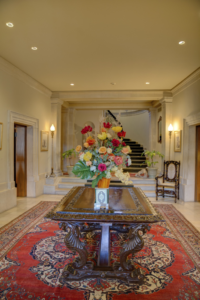 |
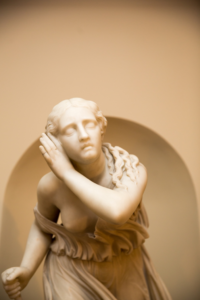 |
| In the entryway, hand-tied Egyptian and Persian rugs lead to an elegant spiral stairway – part of a theme of circles and ovals that is echoed throughout the design of the home. In addition, eighteenth and nineteenth century lithographs and drawings of Egypt adorn the walls of the entryway. |
Standing by the spiral staircase of the entryway is a statue by noted American sculptor Randolf Rogers (1825-1892) entitled, “Nydia, the Blind Girl of Pompeii.” The statue is one of the most popular pieces of American sculpture of the nineteenth century. This version in the Residence is one of several facsimiles that Rogers completed in his lifetime; the life-size original is at the National Gallery of Art. |
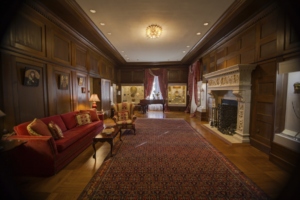 |
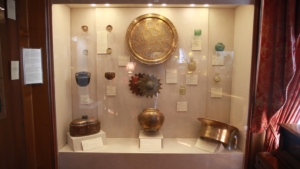 |
| The first floor, or the “Museum of Antiquities”, is the heart of the Residence. Here, display cases are filled with ancient artifacts dating back as early as 3,000 B.C. and spanning Egypt’s diverse cultural heritage, including items with Arab, ancient Egyptian and Coptic Christian influences. |
This display houses a large number of the collection’s vases, urns and glassware, in addition to the spectacular Mamluk-era brass tray at center. The copper and pottery vessels located at the top left, are dated throughout the Old and New Kingdom of Egypt. Jars such as these typically carried cosmetics and were often buried with the deceased for use in the afterlife. |
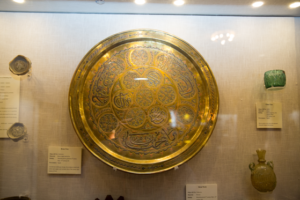 |
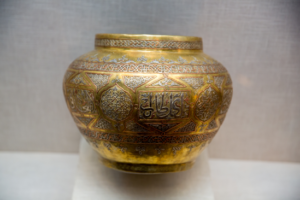 |
| Brass Tray (Mamluk period, 14th century AD): This tray features an intricate arabesque design and scripture inlaid with silver and copper and includes four of the 99 names of God. |
Brass Bowl (Mamluk period, 14th century AD): This copper and silver bowl is inlaid with an arabesque motif, inscribed with the following: “Salvation is in being truthful”; “Education is useful to every seeker of knowledge”; and “Contentment is a never-ending treasure”. |
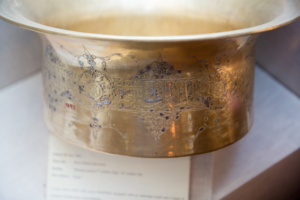 |
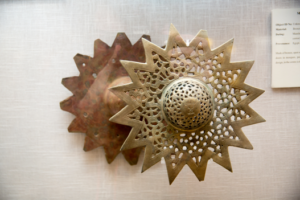 |
| Brass Basin (Mamluk period, 14th century AD): This basin is beautifully designed with an arabesque motif and a band of scripture with the titles of the Mamluk. |
Metal Work (Mamluk period, 14th century AD): This piece has open work design that was used to decorate doors in mosques, palaces, etc. It is part of a whole design and in the center, is the herald of the owner. |
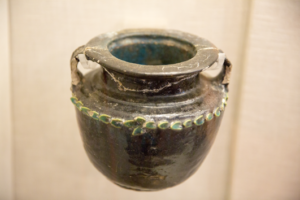 |
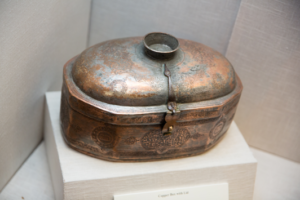 |
| Glazed Pottery Vase (Mamluk period, 14th century AD): This pottery was created to replaced gold and silver vessels which were deemed excessively luxurious and therefore were religiously discouraged. |
Copper Box with Lid (Mamluk period, 14th century AD): This box and lid are intricately engraved with arabesque motif and scripture. The design includes the herald of the owner. |
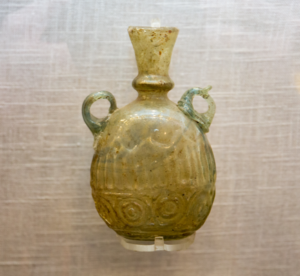 |
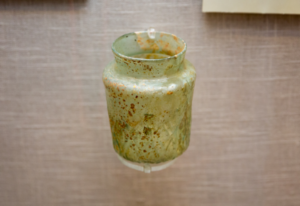 |
| Glass Bottle (Fatmid period, 11th century AD): This bottle has two handles in applied glass and molded decoration. |
Glass Cup (Fatmid period, 11th century AD): This glass cup has a pressed diamond-shaped decoration. |
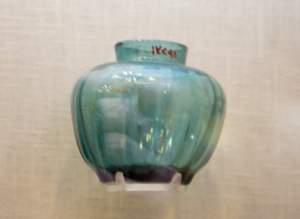 |
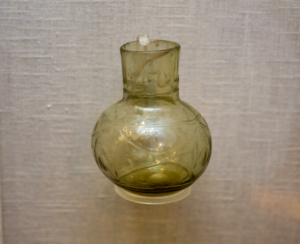 |
| Glass Vase (Fatmid period, 11th century AD): This vase is from the collection of The Museum of Islamic Art and has a green glass vase with a globular body and molded vertical flutes |
Glass Bottle (Fatmid period, 11th century AD): This bottle has cut decoration and is one of the rare specimen of cut glass. |
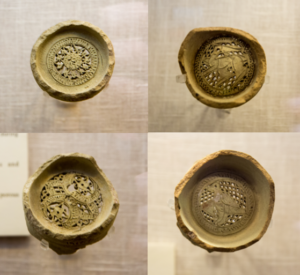 |
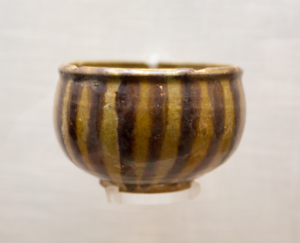 |
| Parts of Drinking Jars (Fatmid period, 11th century AD): These were placed in the neck of drinking jars and perforated so that when water is poured in, it is purified, removing any particles that might be in the water. They also function to prevent the rush of water during drinking. They are decorated with arabesque animals and geometrical patterns. The jars kept the water cool due to their porous nature. |
Glazed Potter Bowl (Fatmid period, 11th century AD): This is from the collection of The Museum of Islamic Art and has a striped design. |
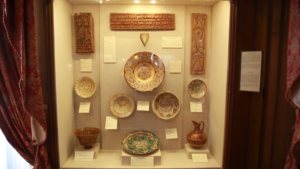 |
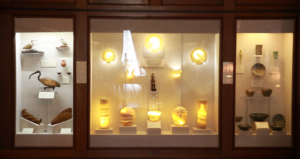 |
| This display features several examples of Islamic woodcarvings and ceramics, art forms which developed and flourished in Egypt for centuries. During the early Islamic Period, wood panels and other ornaments were part of the elaborate decorative scheme of mosques and private houses in Cairo. Screens made up of labyrinths of complicated joinery and is enriched with small carvings are ubiquitous to Cairo’s mosques, residences, municipal buildings and tombs. Islamic ceramics are characterized by the use of metallic luster pottery, a type of porcelain developed by Muslim artists during the Fatimid period. The five plates in the center are part of a collection which belonged to Ali Ibrahim Pasha, who ruled Egypt for eight months in 1848. |
This impressive three-tiered display case features a selection of mummified sacred birds of the pharaohs (left case), a collection of Egyptian alabaster plates and bowls that are handsomely lit from within (middle case), and an assortment of stone bowls and faience statues that date back to the New Kingdom (1550-1100 BC). |
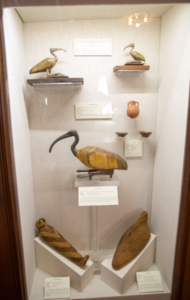 |
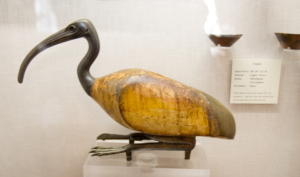 |
| Egyptian nature had a great influence on the formation of the ancient Egyptian pantheon. Gods were thought to be manifesting themselves in cosmic elements as well as certain animals and birds. The selected animal was treated with respect during its lifetime in the temple and was mummified and buried in sacred cemeteries upon its death. Mummified falcons and Ibises were finely wrapped with linen, and bronze legs and beaks were added to the bird mummies occasionally. Mummies were traditionally placed in conical-shaped pottery jars and deposited in niches in underground galleries. From the Seventh century BC onward, pilgrims to the temples of Horus and Thoth traditionally presented falcon and ibis mummies as votive offerings. |
Ibis Mummy (Ptolemaic Period, 3rd-1st centuries BC): This mummy is wrapped in linen bandages, covered with white plaster – which has turned yellow on several parts of the body of the mummy. The beak is made of bronze and details are executed in bold incisions. The feet are also made of bronze and its details are executed in fine and delicate incisions. The tail is also made of bronze, but lacks details of the feathers. |
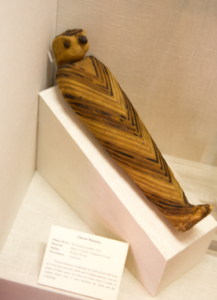 |
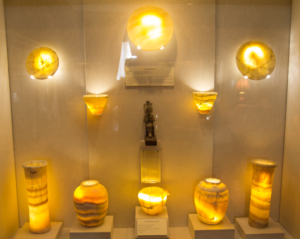 |
| Falcon Mummy (Roman Period): Wrapped in linen, this falcon mummy’s wrappings are linen glued with resin in a very neat structure, the folds take a V-shape patter. Its eyes are made of black glass and its eye-lines are linen. The beak is made of carbon. Black resin is seen between the folds and the wrappings. |
Egyptian Alabaster (Archaic period, 2960-2649 BC): This collection of Egyptian alabaster is from the provenance of Saqqara and was used for daily use. |
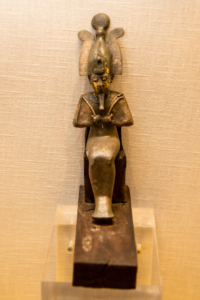 |
 |
| Bronze Statuette of Osiris (Late Period, 600 BC): This seated bronze statuette of Osiris is wearing the Atef crown and holding a flail and heka-scepter (both symbols of authority). The statue was gilded and has remains of that on the left cheek and chest with the eyes inlayed. Osiris was the god of the dead in ancient Egypt. His myth symbolized the cycle of death and rejuvenation. The connection of the Osiris theology with the concept of rejuvenation has made him the god of fertility as well. His images were always painted either blue (the color of the Nile water) or black (the color of the agriculture soil). Bronze statuettes of Osiris were deposited with the dead in the tombs. |
Ushabti Statue (New Kingdom, 1550-1100 BC): Composed of faience, this is one of 365 small statues that were placed inside small wooden coffins that were then buried with the deceased. Their function was to work one day a year in the ever-green field of the afterlife. |
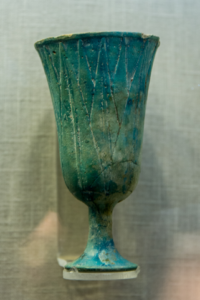 |
 |
| Lotus Flower Cup (New Kingdom, 1550-1100 BC): Composed of faience, this cup is shaped to look like the lotus flower, the emblem of the south and a symbol of life. The lotus flower is an aquatic plant that opens up during the day and closes at night, thus symbolizing life and death. |
Greywacke Stone Bowls (Archaic Period, 2960-2649 BC; Old Kingdom, 2649-2134 BC; Early Old Kingdom, 2649 BC): These bowls are from Saqqara and were used as offering bowls and probably incense. |
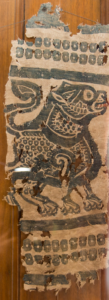 |
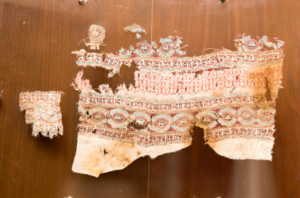 |
| Woolen Textile Fragment (Tulunid period, 9th century AD): This woolen textile fragment is decorated with black ink. |
Woolen Textile Fragment (Fatimid period, 10th century AD): This woolen fabric is decorated with birds and patters in different shades of red. |
 |
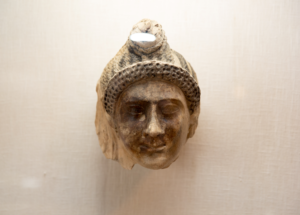 |
| Linen Fabric Fragment (Mamluk period, 14th century AD): This linen fabric fragment is printed with flying ducks and floral motifs. |
Mummy Mask (Greco Roman period, 1st century AD): This mask is made of plaster gilding inlaid with ivory. Mummy masks became popular during the Greco-Roman period. They were placed over the mummy face and the body was wrapped in an intricate design of bandages. Before burial, the mummy was placed in an upright position, inside its sarcophagus (coffin) at home where the family may look at the face of their loved ones. Later, a burial would take place. The mask was placed on the mummy’s face so that the soul could identify the person in the afterlife. |
 |
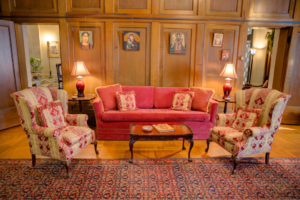 |
| Carnelian Necklace (Old Kingdom, 2700-2000 BC): This necklace was placed on the mummy’s chest inside the bandages as part of the funerary belongings. These jewelry amulets are to help protect the deceased in his journey to the afterlife. In daily life, necklaces were worn by both men and women. They could be as simple as a string of identical beads or very complex compositions of different sizes and shapes of beads on multiple strands of string or metal wire. |
A collection of Coptic icons depicting the infant Christ and the Virgin Mary hangs above the sitting area in the first floor Museum. As one of the oldest branches of Christianity, the Coptic Church traces its roots in Egypt to St. Mark, who is traditionally known as the founder of the church in Egypt in 42 A.D. Today, Coptic Christians are the largest Christian group in the Middle East, with the majority of followers residing in Egypt. |
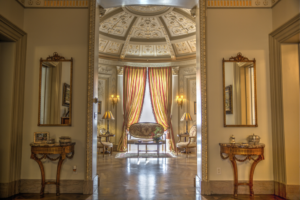 |
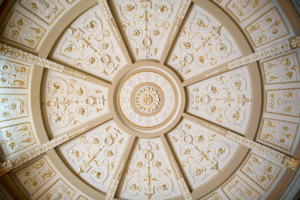 |
| Up the spiral staircase, the second floor of the Residence features some of the building’s most spectacular architecture and design in its formal receiving rooms. In 1973, the United States Fine Art Commission wrote of the building, “The…residence, in the 18th century Roman revival manner, is significant for its plan, spatial composition, and use of detail and material…The interior spaces on the ground floor contract toward the public stair at the rear and on the first floor expand outward from the stair to the street façade. The remarkable interior plasterwork is a foil for the sobriety of the exterior treatment.” |
The Embassy undertook a comprehensive restoration process to preserve and modernize the Residence between 1999 and 2002. The limestone and stucco of the existing façade were restored, while the carriage house and courtyard were renovated. Gold gilding was added to the ceilings and walls of the official quarters to restore the Residence to its full Belle Époque splendor. |
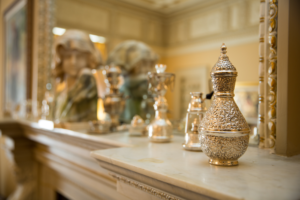 |
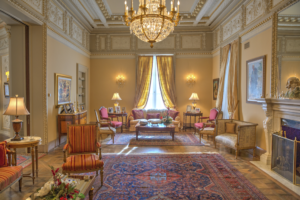 |
| The décor of the Residence is testament to its dual role as a statesman’s home and an exhibition of Egyptian culture. In the main sitting area, intricate molding in the Roman Revivalist style creates a stately effect while Egyptian decoration ranging from jade beetles and golden trinkets to modern oil paintings pay tribute to Egyptian culture. The combination of these two motifs creates a rich style that is truly unique. |
The main salon overlooks Sheridan Circle and incorporates warm reds to complement the gold and cream décor and gilded detailing throughout. Here, the Roman Revival style of the house is again carefully accented with Egyptian details in the paintings, carpets and artifacts. |
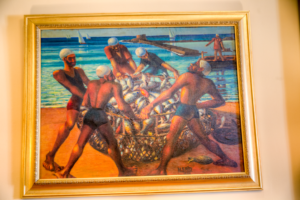 |
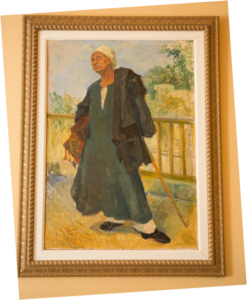 |
| In addition to the home’s impressive collection of priceless artifacts and elaborate interior design and architecture, the Residence boasts a stunning selection of artwork, including this piece, Miraculous Fishing (1933), which was painted by modern Egyptian painter, Mahmoud Said (1897-1964). Said, the son of the prime minister of Egypt from 1910 to 1914, never worked as a professional artist, though his paintings of the cosmopolitan community of his northern port city are central to the history of modern art in Egypt. His vibrant canvases continue to allure viewers with their perplexing range of images from stylized Lebanese landscapes to glamorous Alexandrian aristocrats. |
This untitled piece was painted by Egyptian artist, Youssef Kamel (1890-1971). Born in Cairo, Kamel was among the first students to join the School of Fine Arts in Cairo, belonging to a generation of Egyptian artists commonly referred to as the pioneers, as they were the first to be educated in artistic institutions established according to European models. His work expresses a sense of peacefulness and nostalgic timelessness through the use of light strokes and gentle colors. |
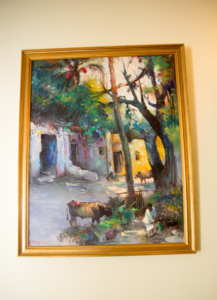 |
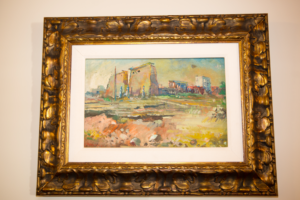 |
| This untitled piece was painted by Egyptian visual artist Hosni El Banani (1912-1989). Born in Cairo, Banani is known for his prolific detail and usage of soft and sublime colors. Several of his works have been sold at auction since is untimely death in 1989, including ‘La danse’, which sold at Christie’s Paris ‘Orientalist Paintings and Modern Arabic and Iranian Art’ in 2010. |
This untitled piece was also painted by Egyptian visual artist Hosni El Banani (1912-1989). |
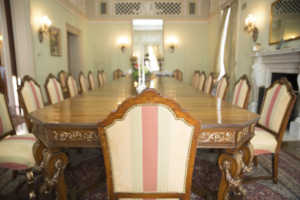 |
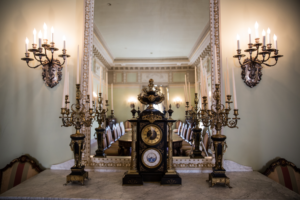 |
| The formal dining room can host up to sixteen guests for meals or a working meeting. The table’s gilded accents echo the elaborate molding around the room’s ceiling, depicting urns and floral designs in a Greco-Roman pattern. |
The dining room’s two mantels display items that echo the house’s neoclassical design and Egyptian influences. The forward mantel features an elegant timepiece of French design which tracks not only the time, but also the progress of the year and zodiac. |
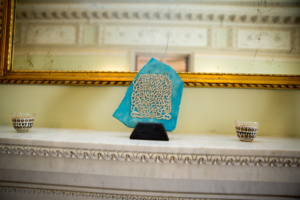 |
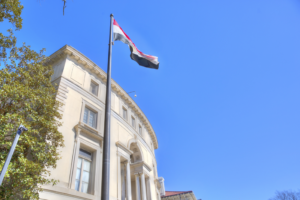 |
| The adjacent mantel features a number of Egyptian items, including a ceramic fragment featuring ornate Arabic calligraphy on a stunning turquoise background. To each side, scarab statuettes echo the iconography of ancient Egypt while complementing the azure theme. |
Thank you for visiting the Residence of the Ambassador of the Arab Republic of Egypt to the United States. We hope that you enjoyed your virtual visit and we look forward to seeing you again soon! |












































